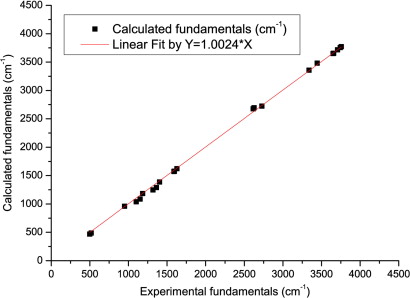
Fig. 1. The least-squares fitting of calculated fundamentals vs. experimental fundamentals. The regression line has a slope of 1.0024.
The Bigeleisen–Mayer equation has been the theoretical corner-stone of stable isotope geochemistry for decades. It is necessary to use harmonic frequencies to justify several of the approximations and the Teller–Redlich product rule employed inside the Bigeleisen–Mayer equation. However, since the publication of the Bigeleisen–Mayer equation in 1947, many researchers have ignored this important requirement. They either directly used experimentally observed fundamental frequencies from vibrational spectra, which include anharmonicity contributions, or used harmonic frequencies from quantum chemical calculations but improperly scaled the frequencies to fit the experimentally observed fundamentals. Such errors have become one of the major error sources in the prediction of equilibrium isotopic fractionation. Moreover, many researchers still use the Bigeleisen–Mayer equation to handle H/D exchange reactions, even though it has been established that the Bigeleisen–Mayer equation is not sufficient for dealing with H/D isotope exchange reactions. This mishandling could easily cause several per mil errors in isotope fractionation factor.
Since quantum chemical calculations now play a central role in understanding stable isotope fractionation, it is necessary to clarify these important issues. Several simple gaseous molecules are used as examples in this study to show how important it is to use pure harmonic frequencies instead of experimental fundamentals within the Bigeleisen–Mayer equation and to use theoretical methods beyond the Bigeleisen–Mayer equation when dealing with the H/D isotope exchange reactions. Adapting the work of Richet et al. (1977), the scientists of Institute of Geochemistry, Chinese Academy of Sciences, also discussed a series of modified formalisms to include higher-order corrections to the Bigeleisen–Mayer equation, such as anharmonicity, quantum mechanical rotation, centrifugal distortion, vibration–rotation coupling, hindered internal rotation, etc. The issues and methods discussed in this study can help to improve the accuracy of theoretical prediction of equilibrium stable isotope fractionation in geochemistry.
| Publication name |
Geochimica et Cosmochimica Acta Volume 74, Issue 24, 15 December 2010, Pages 6965-6983 |
| Author(s) |
Liu, Qi; Tossell, John A.; Liu, Yun |
| Corresponding author |
LIU Yun
liuyun@vip.gyig.ac.cn Chinese Acad Sci, Inst Geochem, State Key Lab Ore Deposit Geochem, Guiyang 550002, Peoples R China |
View here for full text from the publisher